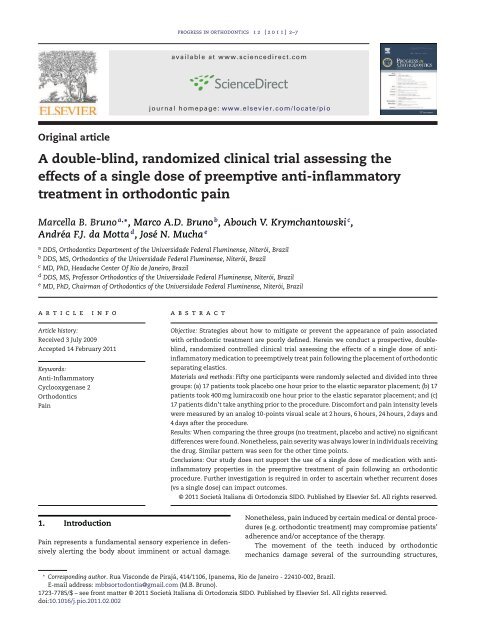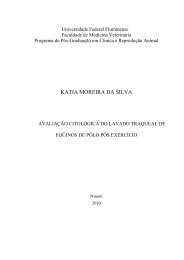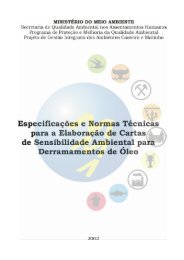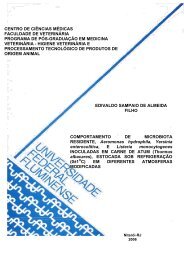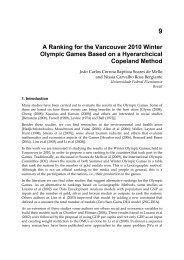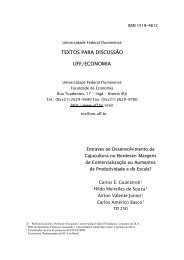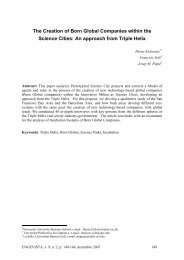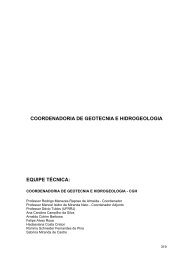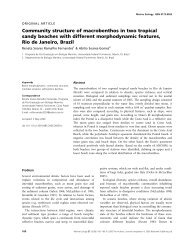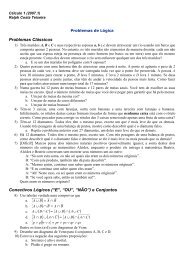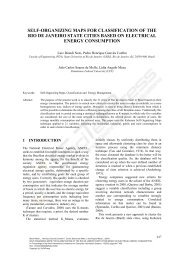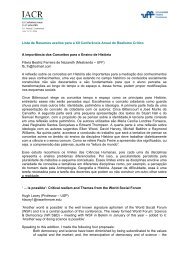A double-blind, randomized clinical trial assessing the effects ... - UFF
A double-blind, randomized clinical trial assessing the effects ... - UFF
A double-blind, randomized clinical trial assessing the effects ... - UFF
Create successful ePaper yourself
Turn your PDF publications into a flip-book with our unique Google optimized e-Paper software.
progress in orthodontics 1 2 ( 2 0 1 1 ) 2–7<br />
available at www.sciencedirect.com<br />
journal homepage: www.elsevier.com/locate/pio<br />
Original article<br />
A <strong>double</strong><strong>blind</strong>, <strong>randomized</strong> <strong>clinical</strong> <strong>trial</strong> <strong>assessing</strong> <strong>the</strong><br />
<strong>effects</strong> of a single dose of preemptive antiinflammatory<br />
treatment in orthodontic pain<br />
Marcella B. Bruno a,∗ , Marco A.D. Bruno b , Abouch V. Krymchantowski c ,<br />
Andréa F.J. da Motta d , José N. Mucha e<br />
a DDS, Orthodontics Department of <strong>the</strong> Universidade Federal Fluminense, Niterói, Brazil<br />
b DDS, MS, Orthodontics of <strong>the</strong> Universidade Federal Fluminense, Niterói, Brazil<br />
c MD, PhD, Headache Center Of Rio de Janeiro, Brazil<br />
d DDS, MS, Professor Orthodontics of <strong>the</strong> Universidade Federal Fluminense, Niterói, Brazil<br />
e MD, PhD, Chairman of Orthodontics of <strong>the</strong> Universidade Federal Fluminense, Niterói, Brazil<br />
a r t i c l e<br />
i n f o<br />
a b s t r a c t<br />
Article history:<br />
Received 3 July 2009<br />
Accepted 14 February 2011<br />
Keywords:<br />
AntiInflammatory<br />
Cyclooxygenase 2<br />
Orthodontics<br />
Pain<br />
Objective: Strategies about how to mitigate or prevent <strong>the</strong> appearance of pain associated<br />
with orthodontic treatment are poorly defined. Herein we conduct a prospective, <strong>double</strong><strong>blind</strong>,<br />
<strong>randomized</strong> controlled <strong>clinical</strong> <strong>trial</strong> <strong>assessing</strong> <strong>the</strong> <strong>effects</strong> of a single dose of antiinflammatory<br />
medication to preemptively treat pain following <strong>the</strong> placement of orthodontic<br />
separating elastics.<br />
Materials and methods: Fifty one participants were randomly selected and divided into three<br />
groups: (a) 17 patients took placebo one hour prior to <strong>the</strong> elastic separator placement; (b) 17<br />
patients took 400 mg lumiracoxib one hour prior to <strong>the</strong> elastic separator placement; and (c)<br />
17 patients didn’t take anything prior to <strong>the</strong> procedure. Discomfort and pain intensity levels<br />
were measured by an analog 10points visual scale at 2 hours, 6 hours, 24 hours, 2 days and<br />
4 days after <strong>the</strong> procedure.<br />
Results: When comparing <strong>the</strong> three groups (no treatment, placebo and active) no significant<br />
differences were found. None<strong>the</strong>less, pain severity was always lower in individuals receiving<br />
<strong>the</strong> drug. Similar pattern was seen for <strong>the</strong> o<strong>the</strong>r time points.<br />
Conclusions: Our study does not support <strong>the</strong> use of a single dose of medication with antiinflammatory<br />
properties in <strong>the</strong> preemptive treatment of pain following an orthodontic<br />
procedure. Fur<strong>the</strong>r investigation is required in order to ascertain whe<strong>the</strong>r recurrent doses<br />
(vs a single dose) can impact outcomes.<br />
© 2011 Società Italiana di Ortodonzia SIDO. Published by Elsevier Srl. All rights reserved.<br />
1. Introduction<br />
Pain represents a fundamental sensory experience in defensively<br />
alerting <strong>the</strong> body about imminent or actual damage.<br />
None<strong>the</strong>less, pain induced by certain medical or dental procedures<br />
(e.g. orthodontic treatment) may compromise patients’<br />
adherence and/or acceptance of <strong>the</strong> <strong>the</strong>rapy.<br />
The movement of <strong>the</strong> teeth induced by orthodontic<br />
mechanics damage several of <strong>the</strong> surrounding structures,<br />
∗ Corresponding author. Rua Visconde de Pirajá, 414/1106, Ipanema, Rio de Janeiro 22410002, Brazil.<br />
Email address: mbbsortodontia@gmail.com (M.B. Bruno).<br />
17237785/$ – see front matter © 2011 Società Italiana di Ortodonzia SIDO. Published by Elsevier Srl. All rights reserved.<br />
doi:10.1016/j.pio.2011.02.002
progress in orthodontics 1 2 ( 2 0 1 1 ) 2–7 3<br />
including <strong>the</strong> periodontal ligaments. Cell membrane damage<br />
triggers <strong>the</strong> release of phospholipids, activation of <strong>the</strong><br />
A2 phospholipase enzymes, and release of arachidonic acid<br />
which in turn stimulates, through <strong>the</strong> action of <strong>the</strong> cyclooxygenase<br />
enzyme, <strong>the</strong> production of prostaglandins, one of <strong>the</strong><br />
key chemical mediators of pain 1 . Clinical consequence include<br />
discomfort, with reduced motivation by <strong>the</strong> patients, 2 masticatory<br />
difficulties, 3–5 sleeping problems and potential overuse<br />
of symptomatic medications. 4,6–9<br />
This problem is not trivial since <strong>the</strong> prevalence, intensity,<br />
frequency and duration of pain (as well as amount of use of<br />
analgesics) seem to be considerably greater after <strong>the</strong> insertion<br />
of orthodontic arch wires than after tooth extractions. 10<br />
The pain occurs in <strong>the</strong> first 3 to 5 days following <strong>the</strong> procedures<br />
and it seems to be greater in adolescents (14 to<br />
17 years old) relative to older ages 11 and within 24 hours of <strong>the</strong><br />
procedure. 9,12<br />
Accordingly, studies have focused on methods to mitigate<br />
pain during <strong>the</strong> course of orthodontic treatment. 13–19 Results<br />
support <strong>the</strong> use of less aggressive orthodontic techniques, <strong>the</strong><br />
use of bubblegums or <strong>the</strong> use of plastic bite sticks within<br />
8 hours of <strong>the</strong> procedures. The latter may increase vascular circulation<br />
on <strong>the</strong> periodontal ligament, with faster symptomatic<br />
release. 13 Low level laser (galliumarsenidealuminium) targeting<br />
<strong>the</strong> gums and focusing on <strong>the</strong> medial third of <strong>the</strong> teeth<br />
root has also been investigated. 14,15 O<strong>the</strong>r studies focused on<br />
CO 2 laser applied to <strong>the</strong> gingival tissue in buccal and palatine<br />
regions of <strong>the</strong> teeth submitted to orthodontic forces. 16<br />
Transcutaneous electric neural stimulation (TENS) has also<br />
been used in order to decrease periodontal pain, ei<strong>the</strong>r applied<br />
intraorally (simultaneous use of electrode probes on <strong>the</strong><br />
crown and palatine mucosa adjacent to <strong>the</strong> tooth) or extraorally,<br />
bilaterally on <strong>the</strong> zygomatic arches 17 as well as on <strong>the</strong><br />
cheek in <strong>the</strong> lower bicuspid area. 18 Finally, vibratory stimulation<br />
produced by patient controlled appliance has also<br />
been assessed to control pain after orthodontic appliance<br />
adjustments. 19<br />
Research has also focused on <strong>the</strong> use of antiinflammatory<br />
and analgesic agents such a ibuprofen, 20–26 aspirin, 20<br />
naproxen sodium, 23,24 acetaminophen 25,26 and valdecoxib. 27<br />
However, few studies focused on <strong>the</strong> preemptive treatment<br />
using antiinflammatory medications (before <strong>the</strong> orthodontic<br />
procedure), 21,27 and evidence to support this approach<br />
is required, ei<strong>the</strong>r to justify it, or to avoid unnecessary<br />
treatments.<br />
Most studies evaluating medications did it so using nonsteroidal<br />
antiinflammatories (NSAIDs), 20–25 which inhibit <strong>the</strong><br />
cyclooxygenase (COX) enzyme, reducing <strong>the</strong> production of<br />
prostaglandins. There are two identified isomers of COX:<br />
Cyclooxygenase 1 (COX1) important for platelet aggregation,<br />
glomerular filtration and gastric protection, and Cyclooxygenase<br />
2 (COX2) mainly involved in inflammation and<br />
considered to be an essential component of <strong>the</strong> inflammatory<br />
cascade that results in edema and pain. 28 Traditional NSAIDs<br />
indiscriminately block both cyclooxygenase (COX) types, and<br />
may cause gastric problems, 29 as well as interference in renal<br />
function, with decreased perfusion, glomerular filtration and<br />
interstitial nephritis. 30–32 Medications that selectively block<br />
COX2 were developed with <strong>the</strong> aim of avoiding interference<br />
with physiological functions. 33<br />
Accordingly, herein we conduct a <strong>randomized</strong> <strong>clinical</strong> <strong>trial</strong><br />
using a COX2 selective inhibitors medication (lumiracoxib) to<br />
preemptively treat pain following <strong>the</strong> placement of orthodontic<br />
separating elastics. We emphasize that although <strong>the</strong> drug is<br />
no longer available in many countries, <strong>the</strong> principle (preemptive<br />
treatment) remains of interest and results are certainly<br />
not specific to <strong>the</strong> drug.<br />
2. Materials and methods<br />
The sample consisted of 87 graduate or postgraduate students<br />
from <strong>the</strong> Dentistry School of Universidade Federal Fluminense,<br />
(Niterói, RJ, Brazil). Of <strong>the</strong>m, 51 completed <strong>the</strong> study<br />
(Table 1). Reasons for dropping <strong>the</strong> study included missing<br />
or incomplete information (n = 18); discomfort due to<br />
<strong>the</strong> elastic bands (n = 10); use of analgesic medication during<br />
study (n = 6). Two lost <strong>the</strong>ir diaries and were unwilling to<br />
be resubmitted to <strong>the</strong> intervention. Participation was voluntary<br />
and all subjects signed an informed consent form. The<br />
form and protocol were approved by <strong>the</strong> University’s Ethics<br />
Committee.<br />
Inclusion criteria were:<br />
1) At least 18 years of age;<br />
2) Presence of second molars and second bicuspids, since separating<br />
elastics had to be fixed on <strong>the</strong> first molars.<br />
3) No <strong>clinical</strong> signs of gingival inflammation.<br />
Exclusion criteria were:<br />
1) Use of any medication that could interfere with results over<br />
two weeks before <strong>the</strong> procedure;<br />
2) Any of <strong>the</strong> following conditions, screened through a questionnaire:<br />
cardiopathies, nephropathies, hepatopathies<br />
and/or gastrointestinal disorders, diabetes, high cholesterol<br />
levels, blood vessel obstructions, allergy to antiinflammatory<br />
drugs, intolerance to lactose, pregnancy.<br />
Tenpoint Visual Analog Scales (VAS) were used for evaluation<br />
of pain intensity on five different occasions. Patients<br />
were instructed to consider “0” as absence of pain, and “10” as<br />
unbearable pain. Based on results, pain levels were stratified<br />
as absent (0), mild (13), moderate (47) and severe (810).<br />
Two separating elastics (Dentaurum GmbH, Ispringen,<br />
Germany) with a diameter of 2.1 mm were placed one on <strong>the</strong><br />
mesial and <strong>the</strong> o<strong>the</strong>r on <strong>the</strong> distal region of <strong>the</strong> first molars<br />
of all participants. The elastics were inserted in <strong>the</strong> proximal<br />
areas of <strong>the</strong> lower left first molars of nearly all subjects, with<br />
<strong>the</strong> exception of 6 patients, where <strong>the</strong> lower right first molars<br />
were used since <strong>the</strong>y were better positioned relative to <strong>the</strong><br />
adjacent teeth.<br />
Patients were randomly assigned into one of three groups<br />
by drawing lots. To ensure similarity in size of <strong>the</strong> groups,<br />
randomization was stratified in blocks of ten (permutedblock<br />
randomization). Those in <strong>the</strong> placebo group took a capsule<br />
Table 1 – Demographics of <strong>the</strong> sample.<br />
Groups Mean age Male Female<br />
APlacebo (n = 17) 22.64 4 13<br />
BLumiracoxib (n = 17) 24.64 4 13<br />
CControl (n = 17) 22.47 5 12
4 progress in orthodontics 1 2 ( 2 0 1 1 ) 2–7<br />
of placebo one hour prior to <strong>the</strong> procedure; those enrolled in<br />
<strong>the</strong> Lumiracoxib group took a capsule of 400 mg of lumiracoxib<br />
one hour prior to elastic placement; those enrolled in<br />
<strong>the</strong> control group did not take any capsule (no treatment).<br />
The placebo and lumiracoxib capsules were perfectly identical<br />
and nei<strong>the</strong>r <strong>the</strong> researchers nor <strong>the</strong> subjects knew <strong>the</strong><br />
groups of each subject, as well as <strong>the</strong> patients of <strong>the</strong> non medication<br />
group knew about <strong>the</strong> use of capsules by <strong>the</strong> o<strong>the</strong>r two<br />
groups.<br />
After <strong>the</strong> placement of separating elastics, participants<br />
were instructed to rate <strong>the</strong>ir VAS at <strong>the</strong> following time intervals:<br />
2 hours, 6 hours, 24 hours, 2 days and 4 days following <strong>the</strong><br />
placement of separating elastics. Patients were asked not to<br />
use any medication during <strong>the</strong> study, as well as to keep proper<br />
oral hygiene, in order to prevent gingival inflammation that<br />
could interfere with results.<br />
2.1. Statistical Analysis<br />
The VAS was given to a statistician <strong>blind</strong>ed to study group.<br />
Summary tables and descriptive statistics were used to summarize<br />
<strong>the</strong> data (central trend, median, variance and standard<br />
deviation).<br />
The KruskalWallis test ( = 0.05) was carried out to estimate<br />
differences in <strong>the</strong> severity of pain across groups, for<br />
each time point. The Friedman test ( = 0.05) was performed<br />
to estimate differences within <strong>the</strong> same group on different<br />
time points and for pairwise comparisons across <strong>the</strong> time<br />
points. A Bonferroni’s posthoc test was applied <strong>the</strong> for multiple<br />
comparisons.<br />
3. Results<br />
The three groups showed similar ages and gender distribution<br />
(Table 1). The three groups had in common <strong>the</strong> fact that<br />
Fig. 1 – Box plot of pain intensity at different time points in<br />
three examined groups.<br />
a feeling of discomfort was observed within <strong>the</strong> first 2 hours,<br />
which became more intense 6 hours later, reaching its peak<br />
24 hours after <strong>the</strong> separating elastics were inserted and lingering<br />
into <strong>the</strong> second day (Fig. 1 and Table 2). In individuals not<br />
receiving any treatment (control group), pain reached moderate<br />
severity at <strong>the</strong> 24hour assessment (median value of 4.0);<br />
it remained moderate at 48 hours (median value of 4.0), and<br />
was rated as mild at 4 days (median value of 2.0). Statistical<br />
differences (p≤0.001) were seen when <strong>the</strong> 2hour period was<br />
compared with 24hour period and 2day period, and when<br />
<strong>the</strong> 6hour period was compared with <strong>the</strong> 24hour period<br />
(p≤0.05).<br />
For <strong>the</strong> placebo group, <strong>the</strong> peak of pain was also observed<br />
after 24 hours (median value of 4.0), as well as in <strong>the</strong> control<br />
Table 2 – Descriptive statistics and statistical comparisons of pain severity at different time points as a function<br />
of treatment group.<br />
Groups<br />
Time Placebo Lumiracoxib Control p (Intergroup)<br />
2 hours 25 th percentile 0.0 0.0 0.0 0.373 ns<br />
Median 0.0 0.0 2.0<br />
75 th percentile 1.0 1.0 2.0<br />
6 hours 25 th percentile 0.0 0.0 0.0 0.345 ns<br />
Median 1.0 1.0 2.0<br />
75 th percentile 3.0 2.0 3.0<br />
24 hours 25 th percentile 2.0 0.0 3.0 0.059 ns<br />
Median 4.0 3.0 4.0<br />
75 th percentile 6.0 4.0 7.0<br />
2 days 25 th percentile 2.0 1.0 3.0 0.076 ns<br />
Median 4.0 2.0 4.0<br />
75 th percentile 4.0 4.0 5.0<br />
4 days 25 th percentile 1.0 1.0 1.0 0.258 ns<br />
Median 2.0 2.0 2.0<br />
75 th percentile 3.0 4.0 5.0<br />
p (Intragroup) 0.000* 0.001* 0.000*<br />
ns: not significant.<br />
* p ≤. 001.
progress in orthodontics 1 2 ( 2 0 1 1 ) 2–7 5<br />
group. Significant differences (p≤0.005) were seen between <strong>the</strong><br />
2 hours and 24 hours, between 2 hours and 2 days and between<br />
6 hours and 24 hours. Significant differences were also present<br />
between 24 hours and 4 days (p≤0.05).<br />
For <strong>the</strong> active group (lumiracoxib), <strong>the</strong> peak of pain (median<br />
value of 3.0) was also recorded after 24 hours. Significant differences<br />
(p≤0.005) were seen between 2 hours and 24 hours and<br />
between 2 hours and 2 days. Significant differences (p≤0.05)<br />
were also assessed between 6 hours and 24 hours and between<br />
6 hours and 2 days.<br />
When comparing <strong>the</strong> three groups (Fig. 1 and Table 2) no<br />
statistically significant differences were found comparing <strong>the</strong><br />
pain intensity in <strong>the</strong> five stages under analysis. None<strong>the</strong>less,<br />
<strong>the</strong> VAS values were always and consistently lower in individuals<br />
receiving drug. Taking <strong>the</strong> 24 hours as an example, median<br />
pain was 4.0 in <strong>the</strong> no treatment group, 4.0 in <strong>the</strong> placebo<br />
group and 3.0 in <strong>the</strong> active treatment group. Similar pattern<br />
was seen for <strong>the</strong> o<strong>the</strong>r time points.<br />
4. Discussion<br />
NSAIDs are peripherallyacting nonopioid analgesics. As<br />
mentioned, <strong>the</strong>y inhibit <strong>the</strong> COX enzymes which modulate<br />
prostaglandin formation from arachidonic acid originated<br />
from <strong>the</strong> rupture of cells membranes. Prostaglandins are<br />
not only essential for <strong>the</strong> inflammatory cascade, but also<br />
for stimulating bone resorption, by increasing <strong>the</strong> number<br />
and function of osteoclasts. 35–37 NSAIDs do not totally<br />
block prostaglandins, but significantly reduce <strong>the</strong>ir formation.<br />
These drugs would be useful in controlling pain secondary to<br />
orthodontic tooth movement, which is in turn triggered by<br />
local tissue inflammation. On <strong>the</strong> o<strong>the</strong>r hand, <strong>the</strong> blockage<br />
of <strong>the</strong> inflammatory response may interfere with <strong>the</strong> alveolar<br />
bone resorption necessary for <strong>the</strong> tooth movement. 34,35<br />
None<strong>the</strong>less, since <strong>the</strong>y are used for short periods of time,<br />
<strong>the</strong>y seem not to cause any significant changes in dental<br />
movement, while providing welcoming postprocedure<br />
analgesia. 36–38<br />
Although pain is an important problem in <strong>the</strong> field of<br />
orthodontics, this topic has, paradoxically, yielded very few<br />
publications. The inflammatory component generated by<br />
orthodontic treatment is well documented, and translates in<br />
intense discomfort to patients. Strategies to treat established<br />
pain or to preempt <strong>the</strong> development of pain in <strong>the</strong> first place<br />
will likely translate into increased adherence to treatment and<br />
improved satisfaction.<br />
Randomized <strong>clinical</strong> <strong>trial</strong>s (RCTs) are <strong>the</strong> best source for<br />
providing reliable, evidencebased information about <strong>the</strong>rapeutics.<br />
Herein we used a prospective, <strong>double</strong><strong>blind</strong> RCT to<br />
estimate <strong>the</strong> value of using an antiinflammatory medication<br />
to preempt pain secondary to orthodontic procedures.<br />
This study presents a few limitations. First, as compared<br />
to align and levelling, simulation of orthodontic treatment<br />
using separator placement may cause less pain. None<strong>the</strong>less,<br />
since pain is an individual experience, some participants<br />
had important pain even after <strong>the</strong>se less important forces;<br />
accordingly, <strong>the</strong> potential for improvement was narrower than<br />
we expected, and consequently we may be underpowered<br />
to see differences, even though it is clear that individuals<br />
receiving <strong>the</strong> active treatment had lower scores of pain for all<br />
assessments. Second, <strong>the</strong> medication used in our study is no<br />
longer available. None<strong>the</strong>less, <strong>the</strong> principle applies, and it is<br />
unlikely that <strong>the</strong> particular choice of medication significantly<br />
alter <strong>the</strong> results. O<strong>the</strong>r Cox2 medications remain available,<br />
and <strong>the</strong> efficacy of <strong>the</strong>m is similar to nonselective antiinflammatory<br />
medications anyway. Strengths of our study<br />
include <strong>the</strong> <strong>double</strong><strong>blind</strong> design and <strong>the</strong> rigorous assessments<br />
and <strong>the</strong> homogeneity of <strong>the</strong> sample.<br />
In <strong>the</strong> present study, we observed that <strong>the</strong> three groups<br />
had some discomfort 2 hours following elastic placement,<br />
which worsened within 6 hours and peaked within 24 hours.<br />
After this period, although <strong>the</strong> discomfort lasted for 2 days, it<br />
gradually improved. Pain peaked 24 hours after <strong>the</strong> orthodontic<br />
procedure, a finding that has been reported by o<strong>the</strong>r<br />
studies. 22,23<br />
As exposed above, although patients receiving active<br />
treatment reported less pain, <strong>the</strong> observed betweengroup differences<br />
were not statistically significant at any of <strong>the</strong> <strong>trial</strong>’s<br />
five stages. Young et al 23 also demonstrated <strong>the</strong> <strong>effects</strong> of<br />
ano<strong>the</strong>r nonsteroidal selective COX2 inhibitor (valdecoxib),<br />
which revealed a tendency towards reducing pain, although<br />
significance was also not achieved. Studies with o<strong>the</strong>r antiinflammatory<br />
medications yielded positive results. 20–25,28<br />
However, studies comparing drugs (which would allow recommendations<br />
about ideal treatment), are missing.<br />
Pain is a subjective feeling characterized by subconscious<br />
arousal and motor inhibition. Being subjective, interindividual<br />
variability is high. That is why, in addition to <strong>the</strong> control group,<br />
we had a no treatment group. The goal was to assess pain<br />
behavior without <strong>the</strong> interference of any expedient that might<br />
affect <strong>the</strong> results.<br />
None<strong>the</strong>less, our study does not support <strong>the</strong> use of a single<br />
dose of medication with antiinflammatory properties in<br />
<strong>the</strong> preemptive treatment of pain following an orthodontic<br />
procedure. Fur<strong>the</strong>r investigation is required in order to ascertain<br />
(i) <strong>the</strong> real usefulness of preemptively using nonsteroidal<br />
antiinflammatory drugs; (ii) <strong>the</strong> most effective dosage; (iii)<br />
<strong>the</strong> most tolerable dosage; and (iv) <strong>the</strong> dosage with fewest<br />
side <strong>effects</strong>. Also if recurrent doses (vs a single dose) impact<br />
outcomes.<br />
5. Conclusions<br />
The present RCT failed to demonstrate <strong>the</strong> benefit of <strong>the</strong><br />
preemptive treatment of pain following an orthodontic procedure,<br />
although <strong>the</strong> group that received a nonsteroidal<br />
antiinflammatory drug reported less pain at all examined<br />
time points.<br />
Conflict of interest<br />
The authors have reported no conflicts of interest.<br />
Riassunto<br />
Obiettivo: Le strategie finora adottate al fine di attenuare o di prevenire<br />
l’insorgenza del dolore associato al trattamento ortodontico<br />
non sono ancora chiaramente e perfettamente definite. Si è deciso di
6 progress in orthodontics 1 2 ( 2 0 1 1 ) 2–7<br />
portare avanti un <strong>trial</strong> clinico controllato, randomizzato, a doppiocieco<br />
e prospettico per valutare gli effetti di una singola dose di<br />
antinfiammatorio per trattare preventivamente il dolore a seguito<br />
dell’inserimento di elastici separatori ortodontici.<br />
Materiali e metodi: Sono stati scelti in modo randomizzato cinquantuno<br />
pazienti che sono poi stati divisi in tre gruppi: (a) a 17<br />
pazienti è stato somministrato placebo un’ora prima dell’inserimento<br />
del separatore elastico; (b) a 17 pazienti sono stati somministrati<br />
400 mg di lumiracoxib un’ora prima dell’inserimento del separatore<br />
elastico; a 17 pazienti non è stato somministrato nulla. I livelli di<br />
discomfort e di intensità del dolore sono stati misurati avvalendosi<br />
di una scala analogica visiva (VAS) a 10 punti, dopo 2 ore, 6 ore, 24<br />
ore, 2 giorni e 4 giorni dal procedimento.<br />
Risultati: Quando raffrontiamo I tre gruppi (nessun trattamento,<br />
placebo e trattamento attivo) non riscontriamo differenze significative.<br />
Nondimeno, l’intensità del dolore è sempre meno accentuata nei<br />
soggetti che assumono il farmaco. Un comportamento simile è stato<br />
riscontrato per le diverse scansioni temporali.<br />
Conclusioni: Il nostro studio non è quindi a favore dell’uso di una<br />
singola dose di farmaco antiinfiammatorio nel trattamento preventivo<br />
del dolore a seguito di un intervento ortodontico. Sono però<br />
necessarie altre ricerche per valutare se dosi ricorrenti (rispetto alla<br />
singola dose) possano avere un’influenza sul risultato finale.<br />
Materiales y métodos: 51 participantes fueron seleccionados de<br />
manera aleatoria y divididos en tres grupos: (a) a 17 pacientes se<br />
les administró placebo una hora antes de la colocación del separador<br />
elástico; (b) a 17 pacientes se les administró 400 mg de lumiracoxib<br />
una hora antes de la colocación del separador elástico; y (c) a 17<br />
pacientes no se les administró nada antes del procedimiento. Los niveles<br />
de molestia y dolor fueron medidos mediante una escala visual<br />
analógica (VAS) de diez puntos al cabo de 2 horas, 6 horas, 24 horas,<br />
2 días y 4 días después del procedimiento.<br />
Resultados: Al comparar a los tres grupos (sin tratamiento, con<br />
placebo y con tratamiento activo) no se experimentan diferencias<br />
significativas. Sin embargo, la severidad del dolor siempre fue más<br />
baja en los sujetos a los que se les administró el fármaco. Un patrón<br />
parecido fue identificado para las otras temporizaciones.<br />
Conclusiones: Nuestro estudio no respalda la utilización de una<br />
simple dosis de fármaco con propiedades antiinflamatorias en el<br />
tratamiento previo del dolor a consecuencia de un tratamiento<br />
ortodóncico. Sin embargo, más investigaciones son necesarias para<br />
comprobar si dosis repetidas (con respecto a la dosis sencilla) pueden<br />
influir en los resultados.<br />
r e f e r e n c e s<br />
Résumé<br />
Objectif: Les stratégies pour atténuer ou pour prévenir l’apparition<br />
de la douleur associée à un traitement orthodontique ne sont pas pour<br />
l’instant bien cernées. On a mené un essai clinique contrôlé, aléatoire,<br />
en <strong>double</strong>aveugle, prospective pour évaluer les effets d’une simple<br />
dose d’antiinflammatoire pour traiter au préalable la douleur se<br />
dégageant du placement d’élastiques de séparation orthodontiques.<br />
Matériels et méthode: Cinquante et un participants ont été choisis<br />
de manière aléatoire et ensuite divisés en trois groupes: (a) on a<br />
administré du placebo à 17 patients, une heure avant le placement<br />
du séparateur élastique; (b) on a administré 400 mg de lumiracoxib<br />
à 17 patients, une heure avant la procédure et (c) on n’a rien administré<br />
à 17 patients avant la procédure. On a mesuré le malaise et<br />
l’intensité de la douleur à l’aide d’une échelle visuelle analogique<br />
(EVA) à 10 points au bout de 2 heures, 6 heures, 24 heures, 2 jours et<br />
4 jours après la procédure.<br />
Résultats: Lorsqu’on compare les trois groupes (aucun traitement,<br />
placebo et traitement actif) on n’enregistré aucune différence significative.<br />
Toutefois, l’intensité de la douleur a été toujours plus faible<br />
chez les sujets qui avaient reçu le médicament. Un modèle semblable<br />
s’impose aussi pour les autres délais de temps.<br />
Conclusions: Notre étude ne soutient pas l’utilisation d’une simple<br />
dose de médicament antiinflammatoire pour traiter de façon<br />
préventive la douleur suite à un traitement orthodontique. D’autres<br />
recherches sont donc nécessaires pour vérifier si des doses répétées<br />
(par rapport à une simple dose) peuvent influencer les résultats.<br />
Resumen<br />
Objetivo: Las estrategias sobre cómo aliviar o prevenir la aparición<br />
de dolor relacionado con el tratamiento ortodóncico están definidas<br />
de manera insatisfactoria. En el caso que nos ocupa, hemos llevado<br />
a cabo un ensayo clínico controlado, aleatorio, de doble ciego<br />
perspectivo que valora los efectos de una simple dosis de fármaco<br />
antiinflamatorio para tratar previamente el dolor, a raíz de la colocación<br />
de elásticos de separación ortodóncicos.<br />
1. Trowbridge HO, Emling RC. Inflammation. A review of <strong>the</strong><br />
process. 5th ed Carol Stream: Quintessence; 1997.<br />
2. Oliver RG, Knapman YM. Attitudes to orthodontic<br />
treatment. Br J Orthod 1985;12:179–88.<br />
3. Sinclair PM, Cannito MF, Goates LJ, Solomos LF, Alexander<br />
CM. Patient responses to lingual appliances. J Clin Orthod<br />
1986;20:396–404.<br />
4. Scheurer PA, Firestone AR, Bürgin WB. Perception of pain as<br />
a result of orthodontic treatment with fixed appliances. Eur J<br />
Ortho 1996;18:349–57.<br />
5. Firestone AR, Scheurer PA, Bürgin WB. Patient’s anticipation<br />
of pain and painralated side <strong>effects</strong>, and <strong>the</strong>ir perception of<br />
pain as a result of orthodontic treatment with fixed<br />
appliances. Eur J Orthod 1999;21:387–96.<br />
6. Jones ML. An investigation into <strong>the</strong> initial discomfort by<br />
placement of an archwire. Eur J Orthod 1984;6:48–54.<br />
7. Kvan E, Bondevik O, Gjerdet NR. Traumatic ulcers and pain<br />
in adults during orthodontic treatment. Commun Dent oral<br />
Epidemiol 1989;3:154–7.<br />
8. Jones ML, Chan C. Pain in <strong>the</strong> early stages of orthodontic<br />
treatment. J Clin Orthod 1992;26:311–3.<br />
9. Erdinç AME, Dinçer B. Perception of pain during orthodontic<br />
treatment with fixed appliances. Eur J Orthod 2004;26:79–85.<br />
10. Jones ML, Chan C. The pain and discomfort experienced<br />
during orthodontic treatment: A <strong>randomized</strong> controlled<br />
<strong>clinical</strong> <strong>trial</strong> of two initial aligning arch wires. Am J Orthod<br />
Dentofacial Orthop 1992;102:373–81.<br />
11. Brown DF, Moerenhout RG. The pain experience and<br />
psychological adjustment to orthodontic treatment of<br />
preadolescents, adolescents, and adults. Am J Orthod<br />
Dentofacial Orthop 1991;100:349–56.<br />
12. Fernandes LM, Ogaard B, Skoglund L. Pain and discomfort<br />
experienced after placement of a conventional or a<br />
superelastic NiTi aligning archwire. J Orofac Orthop<br />
1998;56:331–9.<br />
13. Proffit WR. Contemporary Orthodontics. 3th ed. St Louis:<br />
Mosby; 2000.<br />
14. Lim H, Lew K, Tay D. A <strong>clinical</strong> investigation of <strong>the</strong> efficacy of<br />
low level laser <strong>the</strong>rapy in reducing orthodontic<br />
postadjustment pain. Am J Orthod Dentofacial Orthop<br />
1995;108:614–22.
progress in orthodontics 1 2 ( 2 0 1 1 ) 2–7 7<br />
15. Turhani D, Scheriau M, Kapral D, Benesch T, Jonke E,<br />
Bantleon HP. Pain relief by single lowlevel laser irradiation<br />
in orthodontic patients undergoing fixed appliance <strong>the</strong>rapy.<br />
Am J Orthod Dentofacial Orthop 2006;130:371–7.<br />
16. Fujiyama K, Deguchi T, Murakami T, Fujii A, Kushima K,<br />
TakanoYamamoto T. Clinical effect of CO2 laser in reducing<br />
pain in orthpdontics. Angle Orthod 2008;78:299–303.<br />
17. Roth PM, Thrash WJ. Effect of transcutaneous electrical<br />
nerve stimulation for controlling pain associated with<br />
orthodontic tooth movement. Am J Orthodon Dentofacial<br />
Orthop 1986;90:132–8.<br />
18. Weiss DD, Carver DM. Transcutaneous electrical neural<br />
stimulation for pain control. J Clin Orthod 1994;28:670–1.<br />
19. Marie SS, Powers M, Sheridan JJ. Vibratory stimulation as a<br />
method of reducing pain after orthodontic appliance<br />
adjustment. J Clin Orthod 2003;37:205–8.<br />
20. Ngan P, Wilson S, Shanfeld J, Amini H. The effect of<br />
ibuprofen on <strong>the</strong> level of discomfort in patients undergoing<br />
orthodontic treatment. Am J Orthod Dentofacial Orthop<br />
1994;106:88–95.<br />
21. Law SLS, Southard KA, Law AS, Logan HL, Jakobsen JR. An<br />
evaluation of preoperative ibuprofen for treatment of pain<br />
associated with orthodontic separator placement. Am J<br />
Orthod Dentofacial Orthop 2000;118:629–35.<br />
22. Bernhardt MK, Southard KA, Batterson KD, Logan HL, Baker<br />
KA, Jackobsen JR. The effect of preemptive and/or<br />
postoperative ibuprofen <strong>the</strong>rapy for orthodontic pain. Am J<br />
Orthod Dentofacial Orthop 2001;120:20–7.<br />
23. Polat O, Karaman AI. Pain control during fixed orthodontic<br />
appliance <strong>the</strong>rapy. Angle Orthod 2005;75:210–5.<br />
24. Polat O, Karaman AI, Durmus E. Effects of preoperative<br />
ibuprofen and naproxen sodium on orthodontic pain. Angle<br />
Orthod 2005;75:791–6.<br />
25. Bradley RL, Ellis PE, Thomas P, Bellis H, Ireland AJ, Sandy JR.<br />
A <strong>randomized</strong> <strong>clinical</strong> <strong>trial</strong> comparing <strong>the</strong> efficacy of<br />
ibuprofen and paracetamol in <strong>the</strong> control of orthodontic<br />
pain. Am J Orthod Dentofacial Orthop 2007;132:511–7.<br />
26. Bird SE, Williams K, Kula K. Preoperative acetaminhophen<br />
VS ibuprofen for control of pain after orthodontic separator<br />
placement. Am J Orthod Dentofacial Orthop 2007;132:504–10.<br />
27. Young AN, Taylor RW, Taylor SE, Linnebur AS, Buschang PH.<br />
Evaluation of preemptive valdecoxib <strong>the</strong>rapy on initial<br />
archwire placement discomfort in adults. Angle Orthod<br />
2006;76:251–9.<br />
28. Kömhoff M, Grone HJ, Klein T, Seyberth HW, Nusing RM.<br />
Localization of cyclooxygenase1 and 2 in adult and fetal<br />
human kidney: implication for renal function. Am J Physiol<br />
1997;272(4 Pt 2):F460–8.<br />
29. Ofman JJ, MacLean CH, Straus WL, Morton SC, Berger ML,<br />
Roth EA, Shekelle P. A metaanalysis of severe upper<br />
gastrointestinal complications of nonsteroidal<br />
antiinflammatory drugs. J Rheumatol 2002;29:804–12.<br />
30. Schlondorff D. Renal complications of nonsteroidal<br />
antiinflammatory drugs. Kidney Int 1993;44:643–53.<br />
31. Palmer BF. Renal complications associated with use of<br />
nonsteroidal antiinflammatory agents. J Investig Med<br />
1995;43:516–33.<br />
32. Vane JR, Botting RM. Antiinflammatory drugs and <strong>the</strong>ir<br />
mechanism of action. Inflamm Res 1998;47(Suppl 2):S78–87.<br />
33. Masferrer JL, Zweifel BS, Manning PT, Hauser SD, Leahy KM,<br />
Smith WG, Isakson PC, Seibert K. Selective inhibition of<br />
inducible cyclooxygenase 2 in vivo antiinflammatory and<br />
nonulcerogenic. Proc Natl Acad Sci USA 1994;91:3228–32.<br />
34. Krishnan V, Davidovitch Z. The effect of drugs on<br />
orthodontic tooth movement. Orthod Craniofacial Res<br />
2006;9:163–71.<br />
35. Ohkawa S. Effects of orthodontic forces and<br />
antiinflammatory drugs on <strong>the</strong> mechanical strength of <strong>the</strong><br />
periodontium in <strong>the</strong> rat mandibular first molar. Am J Orthod<br />
1982;81(6):498–502.<br />
36. Wong A, Reynolds E, West VC. The effect of acetylsalisylic<br />
acid on orthodontic tooth movement in <strong>the</strong> guinea pig. Am J<br />
Orthod Dentofac Orthop 1992;102:360–5.<br />
37. Bartzela T, Turp J, Motschall E, Maltha J. Medication <strong>effects</strong><br />
on <strong>the</strong> rate of orthodontic tooth movement: A systematic<br />
literature review. Am J Orthod Dentofacial Orthop<br />
2009;135:16–26.<br />
38. Carlos F, Cobo J, Perillan C, Garcia MA, Arguelles J, Vijande M,<br />
Costales M. Orthodontic tooth movement after different<br />
coxib <strong>the</strong>rapies. Eur J Orthod 2007;29:596–9.


